MisterY
offline

OC God
19 Jahre dabei !
AMD Athlon II
2800 MHz
42°C mit 1.4 Volt
|
      
Inter-Tech K-six Smart Reader Review
- Introduction
- Scope of Delivery
- Technical Data
- Layout, Design and Features
- Conclusion
1. Introduction
Because of the spy scandals many people do not like to give their data into a cloud. They store them instead on local HDDs. But with many pictures, movies, music, etc. a large amount of HDDs are needed and homeservers or self-build NAS are in high demand. To get a huge amount of HDDs into one enclosure, the Inter-Tech K-Six Smart could be interesting, we take a closer look at, today. The K-Six Smart was first announced at CeBIT (see: here) and is available at review date for around 41 EUR.

2. Scope of Delivery
A big thanks goes to Inter-Tech for sending a test sample.
The case was delivered in a brown box ...

... in which the K-Six Smart was packed in another box.
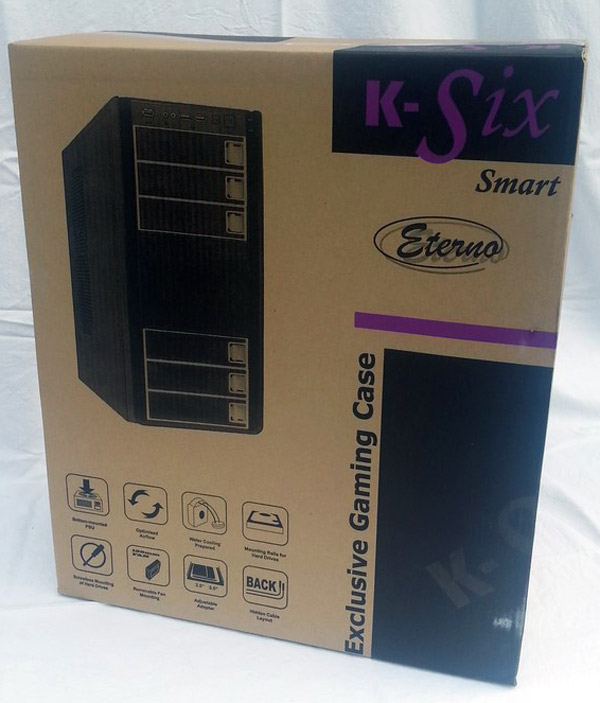
What strikes directly, is that the box is not very heavy. The case itself is wrapped in a bag.
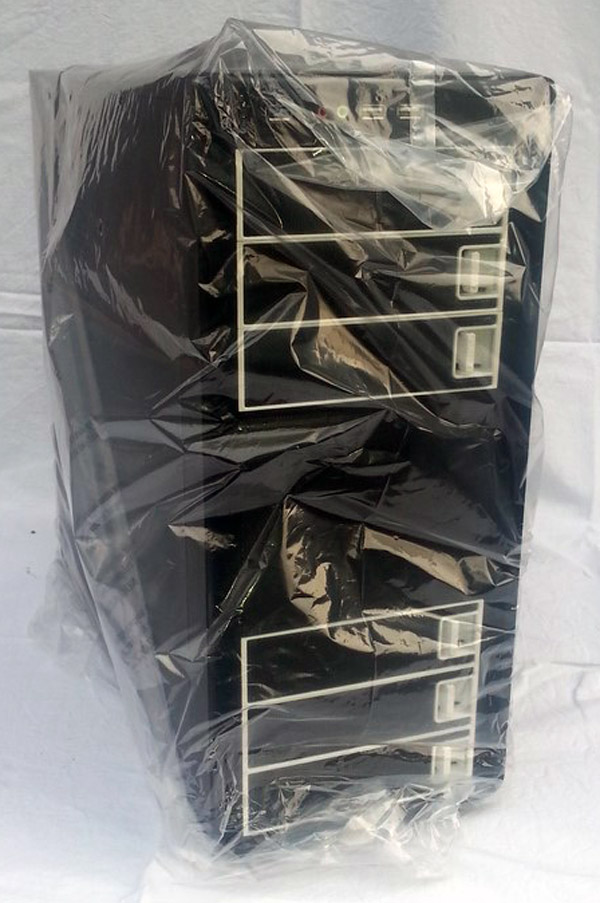
Beside the case, another small box with screws, a graphicscard holder, a speaker, a slot panel

and two additional 5.25" to 3.5"/2.5" adapter frames with a cover are included.
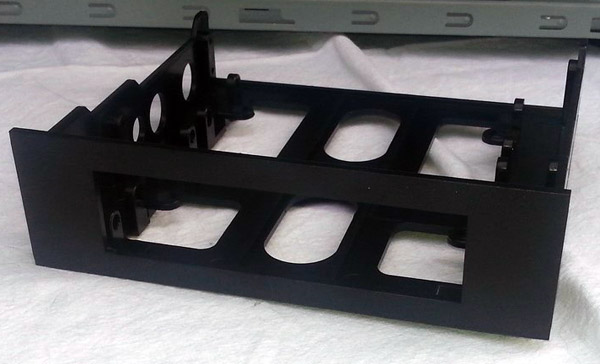

A 120 mm fan with a 3 pin connector is already mounted in the back of the case. A manual is missing. Even on the Webpage of Inter-Tech couldn't be found a manual at the time of this test. So the only way is the try and error method.
3. Technical Data
According to the Inter-Tech webpage, the case has the following dimensions and features - in red are the actual values:
Formfactor: ATX, uATX
Drive bays: 9x 5,25" extern, with adapterframe: 1x 3,5" extern; 2x 3,5" intern or 5x 2,5" intern (4x adapterframe, 1x bottom of the case)
Connectors: 1x USB 3.0; 2x USB 2.0; HD-Audio
Dimensions: 442 x 195 x 500 mm (H/B/T)
Number of fans:
top: 2x120 mm or 1(2)x140 mm
side panel: 2x120mm or 1(2)x140 mm
front: 2x120mm or 1x120 mm
back: 1x92 or 1x120 mm
bottom: 1x120 mm
The fan grid in front, bottom and top are provided with dustfilters.



But only those in the front of the case are made of a foam material, while the others are just meshed grids.
Inter-Tech is very modest and gives the case more Number of (optional) fans as mentioned. This might be better than the opposite way, but advertising potential is lower.
As mentioned above, the box was not very heavy and with a net-weight of 6.32 kg is the case a flyweight. This is due to thin side panels, which bring the problem that they're not very rigid and so you may take a few attempt to fit them right.
4. Layout, Design and Features
The case is a classical midi-tower, outside colored in mat black and inside in "old computer grey". At the outside the case looks pretty nice, but is very unspectacular at the inside, but without a side-windows you can't see anything.
The front is noticeable. It consists of six 5.25" quick lock covers with dustfilters. As mentioned on the webpage of Inter-Tech they should be buyable seperatly, but they're nowhere listed. In the middle of the front is a broad dustfilter, beyond a mesh grid. Both can be released. The I/O-panel is placed on top of the front and is placed in a row. The Power (blue) and the HDD-LED (red) are right next to it the upper right corner of the front.
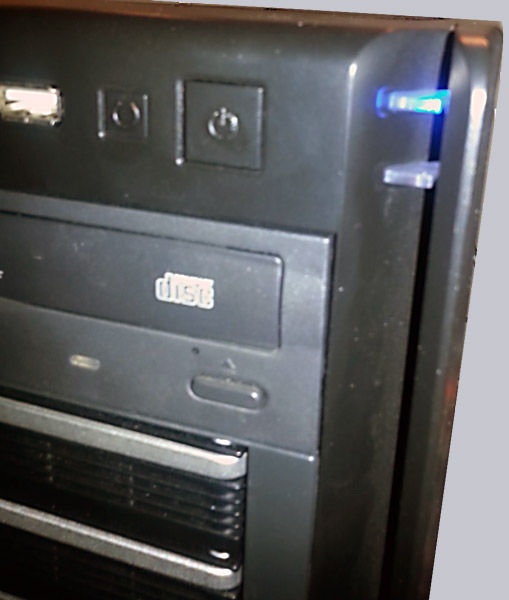
The left side panel has to spaces for fans (120 or 140 mm). Using a Tower-Cooler on the CPU meight avoid the use of the top fan on the side.

The back is typically for a midi-tower, the power supply is placed at the bottom, a fan with 92 or 120 mm can be placed and even two holes for an external watercooler is placed on the rearside. As you can see on the picture, a slot bracket is missing and can be found in the small box. Later more.

The right side panel has been kept simple.
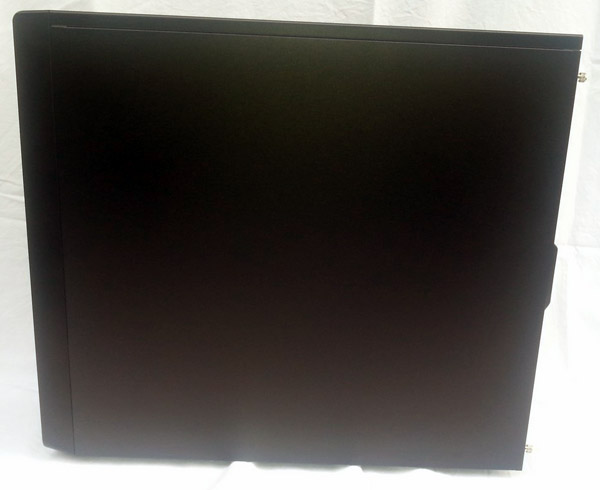
Unfortunatly, the gap of the top at the front (left above on the picture) is too big, so the grey inside can be seen.
In the top two 120 or 140 mm fans can be mounted, which are covered by a mesh-grid. This grid is fixed with push pins, which can be released easily but after releasing they can't be placed back again. But they're way too short for mounting fans.

The dust filter on the outtaking fans just impede the air to get blown out. This filter should be better placed on the side panel, what can be easily done, because the hole spacing is the same. The top fans should be mounted before installing a motherboard, because afterwards it is almost impossible to install them. Furthermore, the size of the CPU-cooler should be considered to avoid a collision with the fans.

It is possible to mount a 240 or 280 mm radiator in the top.
The bottom has a dust filter for the power supply and for a 120 mm fan. The filter can be released easily, but putting it back in could be a little bit harder. The thumb-screws of the side panels cannot be gripped well because of the small tip.
The finish in the inside is not that bad, but ok. Most is burred, but not all of the case.
The motherboard tray has a big hole so a CPU cooler can be mounted while the motherboard is installed in the case.

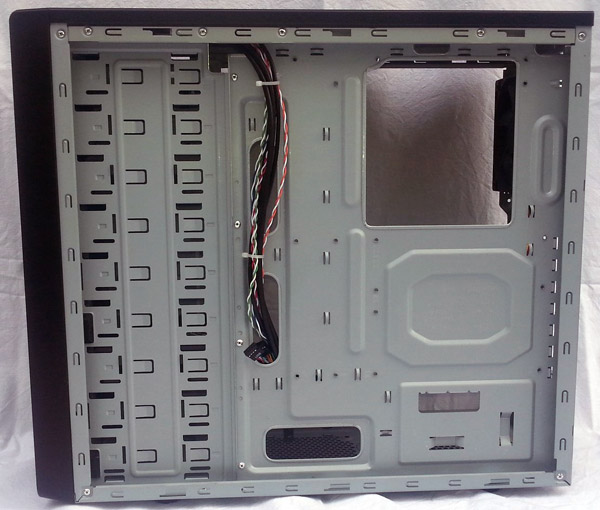
Even good dimensioned openings for cables are placed in the case.Even a opening for the 12V cable of the CPU is available:
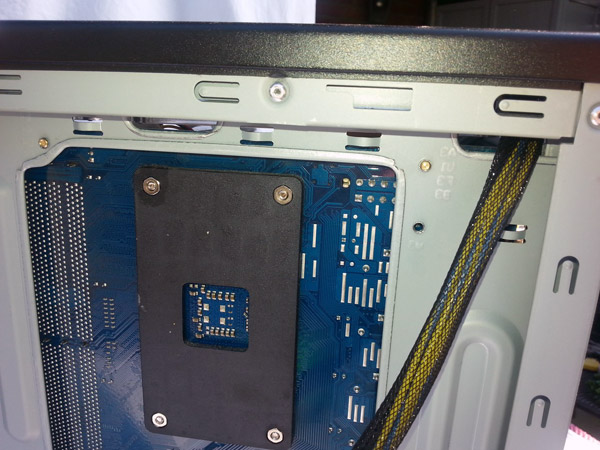
...but only can be used if there is a 120 mm fan or no fan is installed in the top. But without a windows you can decide, if you place the cable across the motherboard or you install a smaller fan or no in the backward top fan position.
What can be seen directly in the inside of the case: the slot brackets must have to be break out. It is inconceivably that such things are still produced in a new case and not in a case of the early 2000s. Even in the price segment of about 40 € one is accustomed something else... So if you change your 2-Slot graphics card to a 1-slot one you will have a gap in the back of the case. The first bracket is missing and can be found in the small box, but most motherboards cannot mount graphics cards at this position, only a slot underneath. The drives can be mounted tool-less, so it would have been great if the extension cards could be mounted tool-less as well.
The of the nine 5.25" drive bays are equipped with good working quick locks.

The 3.5" adapter frames are fixed with retaining lugs. But without a manual first you have to find the opening mechanism. On the side looking at the picture

...is a smal handle, which must be turned up.

Then the adapter frame can be released. In this one 3.5" or two 2.5" HDDs/SDDs can be mounted. Both have decoupling rubbers, which are working fine. But a drawback: To release the 3.5" HDDs out of the frame is not very easily.

releasing the 5.25" covers, the first 120 mm fan holder can be seen.
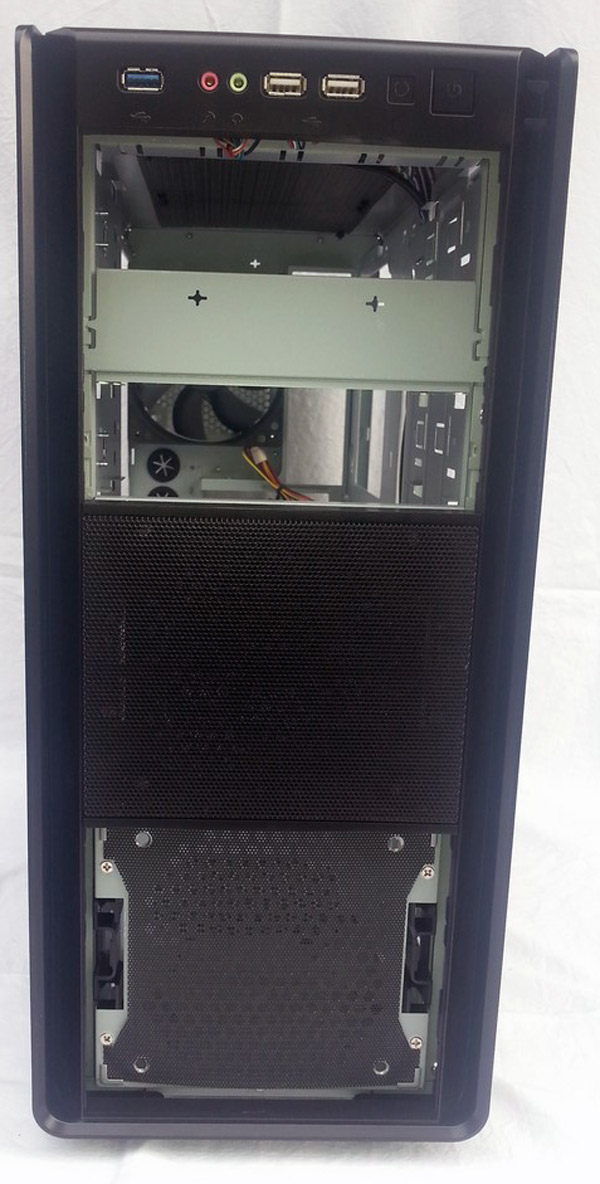
The second one is placed in the middle of the front and can be accessed after dismantling of the frontcover, what is very easy.
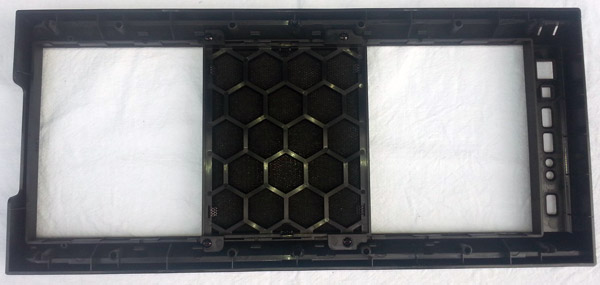
The fan frames have an additional dust-filter, which can be released easily.

Fans with 120 mm of diameter can be installed.
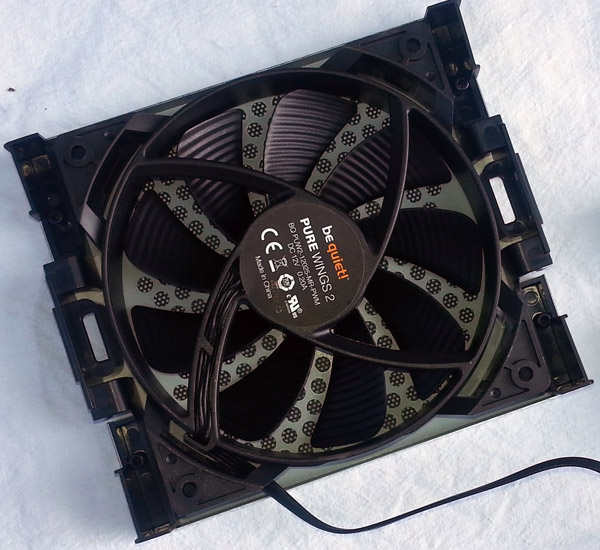
A 240 mm radiator could be placed in the front as well, but maybe only without HDDs.
At the bottom an additional 120 mm fan can be installed, but could bring a problem with the cables of the power supply if those are not well placed. But a fan grid could be better for the healthy of the cables.

The powersupply is placed on four small rubbers.
The installation of the hardware was really easy and went fast. After placing the spacers, the motherboard can be installed.

The HDDs with its frame should be installed before the power supply, or they should be installed from the front. For extra long graphic cards, Inter-Tech made a video card bracket.
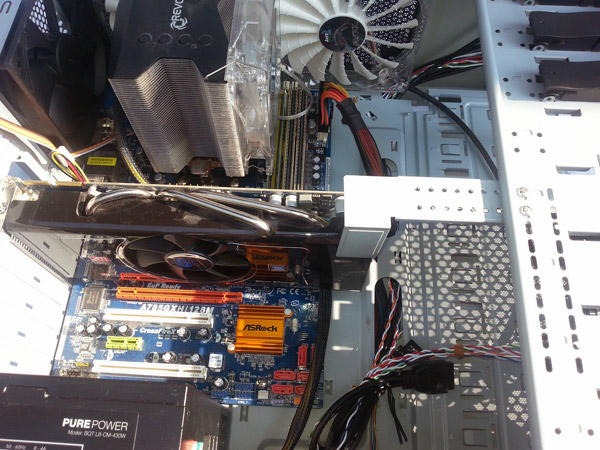
But it is only useful, when you're using a long graphics card. Has the Card a fan at the end of it the holder may not be used. The holder protects the graphics card with a rubber pad to avoid scratches and electrical problems.

A drawback is the length of the front HD-Audio cable. It is just way too short.

There is an extension installed, but with less wires and a different name, many users could be confused without a manual. The Front USB 3.0 Port can also be installed on a 2.0 header. The HD-Audio cable is to short, the cable for the power nad HDD-LEDs are too long. But better too long than way too short.
CPU-cooler with a maximum height of 160 mm can be used.

Graphics cards in almost all length can be installed.
If everything ins installed properly, it should look like this:


Because of the many 5.25" spaces this case can be used to use HDD frames to place many HDDs into the case. That's why this scenario is tests as well.
For example frames of Icy Dock or Cooler Master can be used very well.

The dust filter in the middle on the front has enough space beyond, to place a HDD frame with fan behind it.

With this configuration, eleven 3.5" HDDs can be mounted, with other frames, 15 HDDs can be possible as well.
motherboard: ASRock A785GXH/128M
CPU: AMD Athlon II X4 630
CPU cooler: Revoltec Pipe Tower Pro
RAM: 8GB DDR2
Graphics card: Sapphire ATI Radeon HD4870 1GB
HDD: 1TB Toshiba
And for the "extreme Test": 3TB Toshiba, 2TB Toshiba, 1,5TB Seagate.
Bluray: LG
Software: AIDA Engineer tool
Note: first, only the pre-mounted fan was tested, later other where switched on.
What can be recognized at the first starting: Nothing, and that's the way it should be. The fan is very quit. It can be regulated from 715 up to 1330 rpm. Despite of the thin panels no vibrations can be heard.
With the pre-mounted fan the warm air is blown out, but it is advisable to install at minimum some fans in front of the HDDs what is done quick because of the fan frames.
The temperatures are shown in the following tables/diagrams.
Idle:

Load:
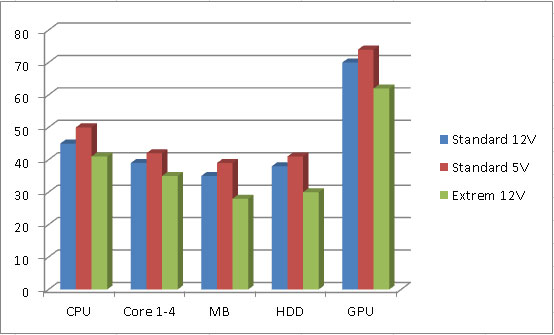
At the "standard 12V mode" the back and cpu fan where set to 12V, at the "standard 5V mode" they were set to 5V. Other fans did not operate at this time. At the "extreme 12V Mode" a 120mm fan in the front sucking fresh air in and two additional 140mm fan in the top blowing out were installed, just to show the cooling potential of this case. Also 3 additional HDDs were installed. The cooling potential is quiet well, but all fans with 5V should be enough even for hardcore-gaming.
5. Conclusion
Because of the open, with dust filter provided front and the many optional fan spaces, this case can be used for high-end components. Even silent enthusiasts and friends of water cooling stuff can be happy with this case. But the biggest point is the potential for using as a home server. But there are some drawbacks left, the quality is at some points not the state-of-the-art, even for 40 EUR. Overall this Inter-Tech K-six Smart case is yet quite recommendable.
Pro:
+ Intuitive front, many spaces for fans and HDDs
+ many dust filters
+ front covers are easily to replaced
+ two fan frames with dust filters
+ enough space for water cooler
+ cable managment
+ optical decent, but interessant
+ great cooling capacity
+ easy and fast hardware installation
+ enough space for long graphics cards
+ grahpics cards holder for long cards
+ great decoupling of the powersupply and the HDDs
+ quick lock for three 5.25" drives
+ no vibrations recognizable
+ pre installed fan is quiet good.
Neutral:
o CPU-cooler with maximal 160mm installable. More is not possible. No informations could be found.
Contra:
- Despite good workmanship, there are some sharp edges
- gaps of the side panels to the front
- not reusable slot brackets
- thin side panels are not easily to get fit
- disassembling of HDDs from the carrier is not easily
- no manual, even not online
|